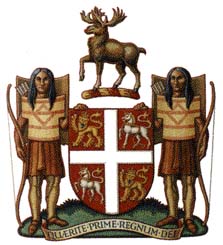But here goes. In order to "officially" use a coat of arms, you have to get the paperwork past an arms-granting body, like a royal college of arms or something like that. They check to make sure that it isn't a copy of someone else's, or that nobody else has something similar which could create confusion. Then they formally give you permission to use it. Each country has its own system -- in this case, I'm assuming it's the Irish arms-granting authority, since that's the suffix on the URL.
I'm just saying this off the top of my head (haven't got my reference books here), and no doubt someone more in the know will straighten me out if I'm mistaken. You don't have to get the whole shebang -- the shield with stuff on it, the figures flanking the shield (the supporters), the thingy on top of the helmet (the crest), the mantling (cloth in particular colors dangling from the crest), etc. The document you showed seems to be a price list for these different components. I guess you can get a set of supporters if your arms didn't include them, or just a badge (distinctive symbol, often the same one featured as the crest which tops the helmet if you already have a coat of arms). By "emblazon", I think they mean getting a proper description in heraldic language. It sometimes means an artistic drawing of the coat of arms, but that seems to be included as a different item, towards the end of the price list.
In Britain, one famous historical badge is the white hart of Richard II (people who approved of him -- a different kind of "supporter"! -- wore it as a brooch or something). It was a type of personal insignia, not the same thing as the royal crown.
http://www.library.phila.gov/medieval/badge.htmWhy register a badge as opposed to a full coat of arms? The Society for Creative Anachronism (one of the few groups that uses heraldry on a regular basis) has some people who follow the official rules pretty carefully, and they say that badges are particularly useful if you want to have a bunch of people wearing that symbol, not just one official grantee -- an organization or a household (though in the real world, people tend not to have a lot of servants, let alone ones wearing something that has a feudal connotation like a personal badge). Here's their explanation:
http://www.sca.org/heraldry/laurel/lessons/lesson13.html Badges are particularly famous in Scotland, where entire clans would use one symbol, like this. They couldn't use the entire coat of arms (that belonged to the chief), but the crest from the coat of arms, encircled by a garter, was okay for ordinary clanspeople. Sometimes they would put a sprig of a particular kind of plant (different for each clan) in their caps, if they couldn't afford an official badge.
 http://www.tartanweb.com/view/cap_badges/scottish_clan_hat_badge_pewter.html
http://www.tartanweb.com/view/cap_badges/scottish_clan_hat_badge_pewter.htmlHere's an example of a (mostly) full coat of arms -- for the province of Newfoundland, in Canada. It's got the shield, the supporters (in this case two aboriginals in native garb), a motto, and a torse (colored heraldic wreath) that would go on top of the helmet, with an elk as the crest. (The locals say it should really be a moose or a caribou.)

Original document with grant of arms (1638), by the Garter King of Arms (one of the British officials allowed to grant arms).
http://www.durham.net/~kburt/NFCoatOfArmsExplanation.htmlArmorial bearings for the town of Penhold, Alberta.

More about the granting process -- in Canada, anyway (your mileage may vary!).
http://www.gg.ca/heraldry/pg/index_e.asp